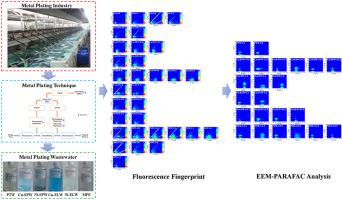Environmental Research ( IF 7.7 ) Pub Date : 2021-01-09 , DOI: 10.1016/j.envres.2021.110713 Jian Shen , Bo Liu , Yidi Chai , Chuanyang Liu , Cheng Cheng , Jing Wu

|
To prevent the illegal discharge of metal plating wastewater (MPW), it is necessary to explore a monitoring method that could achieve the identification of MPW in natural water bodies. Fluorescence excitation-emission matrix-parallel factor (EEM-PARAFAC) analysis might be a promising tool for the detection of MPW. However, before conducting the practical monitoring, the apparent fluorescence features of different kinds of MPW must be first understood. In this study, six types of MPW (576 samples) from ten metal plating plants were collected and their fluorescence fingerprints (FFs) were characterized by EEM-PARAFAC analysis. Results showed that pretreatment wastewater (PTW), copper-contained electroplating wastewater (Cu-EPW), copper-contained electroless wastewater (Cu-ELW), nickel-contained electroplating wastewater (Ni-EPW), Ni-ELW, and metal plating effluent (MPE) presented one, three, one, one, two, and three types of FFs, respectively. Among them, three individual fluorescent components were identified in Ni-EPW and two were decomposed in other kinds of MPW. Owing to the discrepancies of production processes, electroplating additives, wastewater treatment techniques, and management levels, different metal plating plants owned different FFs. By spectral comparison, the tyrosine-like components in PTW and Ni-ELW might derived from some phenolic and benzenesulfonic acidic compounds. Fluorescent component similarity analysis indicated that EEM-PARAFAC technique could distinguish the raw and treated MPW. This study not only constructed the first FF database for MPW, but also provided valuable guidance for their practical monitoring in aquatic environment.
中文翻译:

荧光激发-发射矩阵表征不同类型金属电镀废水的荧光指纹图谱
为了防止金属电镀废水(MPW)的非法排放,有必要探索一种监测方法,以实现对自然水体中MPW的识别。荧光激发-发射矩阵平行因子(EEM-PARAFAC)分析可能是检测MPW的有前途的工具。但是,在进行实际监控之前,必须首先了解不同种类MPW的表观荧光特征。在这项研究中,从十个金属电镀厂中收集了六种类型的MPW(576个样品),并通过EEM-PARAFAC分析对其荧光指纹(FF)进行了表征。结果显示预处理废水(PTW),含铜电镀废水(Cu-EPW),含铜化学废水(Cu-ELW),含镍电镀废水(Ni-EPW),Ni-ELW,金属电镀废水(MPE)分别呈现一种,三种,一种,一种,两种和三种类型的FF。其中,在Ni-EPW中鉴定出三个单独的荧光成分,而在其他MPW中则分解了两个。由于生产工艺,电镀添加剂,废水处理技术和管理水平的差异,不同的金属电镀厂拥有不同的工厂。通过光谱比较,PTW和Ni-ELW中的酪氨酸样成分可能源自某些酚和苯磺酸化合物。荧光成分相似性分析表明,EEM-PARAFAC技术可以区分原始和处理的MPW。这项研究不仅为MPW建立了第一个FF数据库,而且为它们在水生环境中的实际监测提供了有价值的指导。











































 京公网安备 11010802027423号
京公网安备 11010802027423号